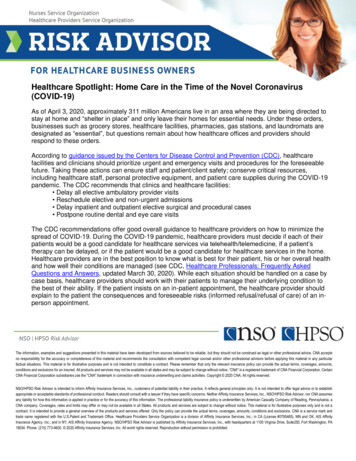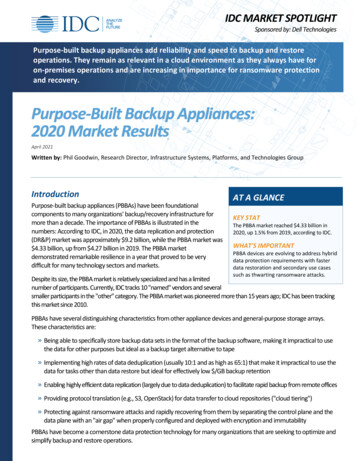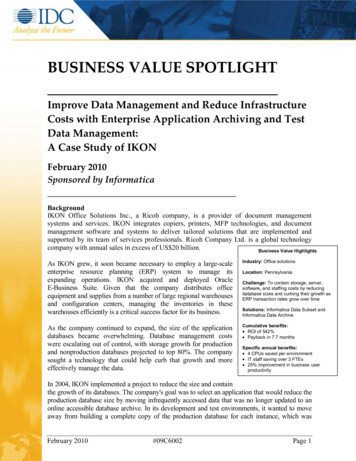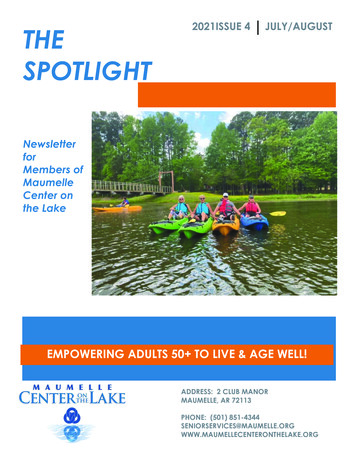
Transcription
Healthcare Spotlight: Home Care in the Time of the Novel Coronavirus(COVID-19)As of April 3, 2020, approximately 311 million Americans live in an area where they are being directed tostay at home and “shelter in place” and only leave their homes for essential needs. Under these orders,businesses such as grocery stores, healthcare facilities, pharmacies, gas stations, and laundromats aredesignated as “essential”, but questions remain about how healthcare offices and providers shouldrespond to these orders.According to guidance issued by the Centers for Disease Control and Prevention (CDC), healthcarefacilities and clinicians should prioritize urgent and emergency visits and procedures for the foreseeablefuture. Taking these actions can ensure staff and patient/client safety; conserve critical resources,including healthcare staff, personal protective equipment, and patient care supplies during the COVID-19pandemic. The CDC recommends that clinics and healthcare facilities: Delay all elective ambulatory provider visits Reschedule elective and non-urgent admissions Delay inpatient and outpatient elective surgical and procedural cases Postpone routine dental and eye care visitsThe CDC recommendations offer good overall guidance to healthcare providers on how to minimize thespread of COVID-19. During the COVID-19 pandemic, healthcare providers must decide if each of theirpatients would be a good candidate for healthcare services via telehealth/telemedicine, if a patient’stherapy can be delayed, or if the patient would be a good candidate for healthcare services in the home.Healthcare providers are in the best position to know what is best for their patient, his or her overall healthand how well their conditions are managed (see CDC, Healthcare Professionals: Frequently AskedQuestions and Answers, updated March 30, 2020). While each situation should be handled on a case bycase basis, healthcare providers should work with their patients to manage their underlying condition tothe best of their ability. If the patient insists on an in-patient appointment, the healthcare provider shouldexplain to the patient the consequences and foreseeable risks (informed refusal/refusal of care) of an inperson appointment.The information, examples and suggestions presented in this material have been developed from sources believed to be reliable, but they should not be construed as legal or other professional advice. CNA acceptsno responsibility for the accuracy or completeness of this material and recommends the consultation with competent legal counsel and/or other professional advisors before applying this material in any particularfactual situations. This material is for illustrative purposes and is not intended to constitute a contract. Please remember that only the relevant insurance policy can provide the actual terms, coverages, amounts,conditions and exclusions for an insured. All products and services may not be available in all states and may be subject to change without notice. “CNA" is a registered trademark of CNA Financial Corporation. CertainCNA Financial Corporation subsidiaries use the "CNA" trademark in connection with insurance underwriting and claims activities. Copyright 2020 CNA. All rights reserved.NSO/HPSO Risk Advisor is intended to inform Affinity Insurance Services, Inc., customers of potential liability in their practice. It reflects general principles only. It is not intended to offer legal advice or to establishappropriate or acceptable standards of professional conduct. Readers should consult with a lawyer if they have specific concerns. Neither Affinity Insurance Services, Inc., NSO/HPSO Risk Advisor, nor CNA assumesany liability for how this information is applied in practice or for the accuracy of this information. The professional liability insurance policy is underwritten by American Casualty Company of Reading, Pennsylvania, aCNA company. Coverages, rates and limits may differ or may not be available in all States. All products and services are subject to change without notice. This material is for illustrative purposes only and is not acontract. It is intended to provide a general overview of the products and services offered. Only the policy can provide the actual terms, coverages, amounts, conditions and exclusions. CNA is a service mark andtrade name registered with the U.S.Patent and Trademark Office. Healthcare Providers Service Organization is a division of Affinity Insurance Services, Inc.; in CA (License #0795465), MN and OK, AIS AffinityInsurance Agency, Inc.; and in NY, AIS Affinity Insurance Agency. NSO/HPSO Risk Advisor is published by Affinity Insurance Services, Inc., with headquarters at 1100 Virginia Drive, Suite250, Fort Washington, PA19034. Phone: (215) 773-4600. 2020 Affinity Insurance Services, Inc. All world rights reserved. Reproduction without permission is prohibited.
During this public health emergency period, some healthcare providers and healthcare business ownersmay be considering expanding service offerings to include healthcare services in the patients’ homes.However, as services change or expand, new exposures may arise from both a regulatory andprofessional liability perspective. The home care environment presents a wide array of injury and liabilityconcerns for patients, healthcare providers and healthcare business owners. A comprehensive risk controlprogram that identifies and addresses common exposures is essential to enhance worker and patientsafety and minimize potential loss.Establishing Home Care ServicesTo diminish potential risk exposures, healthcare providers must ensure that services provided in thepatient’s home comport with state practice regulations, as well as the rules and regulations of applicablestate licensing or certification boards. In addition, healthcare providers and healthcare business ownersshould thoroughly evaluate prospective patients for their care requirements and prepare detailed serviceplans based upon their medical condition, degree of orientation and functional capability. Comprehensiveguidelines for client screening, assessment and service planning help ensure that personal and home careorganizations comply with statutory and regulatory mandates, while also demonstrating their capability toprovide the necessary physical and human resources, staff expertise and range of services that clientsrequire. For more detailed information specific to providing healthcare in the home care setting, pleaserefer to the following resources as a starting point: The U.S. Centers for Medicare & Medicaid Services The Joint Commission National Association for Home Care & Hospice (NAHC)Policies and procedures. Written employment policies are intended to establish behavioral expectationsand delineate the consequences of noncompliance. Employment policies should address the followingareas, among others: Delegation and supervision: Special attention should be given to delegation of duties bylicensed healthcare staff, in order to ensure that unlicensed assistive personnel do not provideclinical care beyond their training or regulatory limits. Monitoring: Supervisors should make periodic unannounced telephone calls to patient homesand conduct documented in-person interviews with patients and family members.Questions should focus on care issues, finances, and evidence of undue provider influence orinappropriate actions. Boundaries: Healthcare providers should be educated about professional boundary issues andshould avoid any activities with patients that fall outside of professional standards and the plan ofcare. Healthcare should be conducted in an open and straightforward manner, and providersThe information, examples and suggestions presented in this material have been developed from sources believed to be reliable, but they should not be construed as legal or other professional advice. CNA acceptsno responsibility for the accuracy or completeness of this material and recommends the consultation with competent legal counsel and/or other professional advisors before applying this material in any particularfactual situations. This material is for illustrative purposes and is not intended to constitute a contract. Please remember that only the relevant insurance policy can provide the actual terms, coverages, amounts,conditions and exclusions for an insured. All products and services may not be available in all states and may be subject to change without notice. “CNA" is a registered trademark of CNA Financial Corporation. CertainCNA Financial Corporation subsidiaries use the "CNA" trademark in connection with insurance underwriting and claims activities. Copyright 2020 CNA. All rights reserved.NSO/HPSO Risk Advisor is intended to inform Affinity Insurance Services, Inc., customers of potential liability in their practice. It reflects general principles only. It is not intended to offer legal advice or to establishappropriate or acceptable standards of professional conduct. Readers should consult with a lawyer if they have specific concerns. Neither Affinity Insurance Services, Inc., NSO/HPSO Risk Advisor, nor CNA assumesany liability for how this information is applied in practice or for the accuracy of this information. The professional liability insurance policy is underwritten by American Casualty Company of Reading, Pennsylvania, aCNA company. Coverages, rates and limits may differ or may not be available in all States. All products and services are subject to change without notice. This material is for illustrative purposes only and is not acontract. It is intended to provide a general overview of the products and services offered. Only the policy can provide the actual terms, coverages, amounts, conditions and exclusions. CNA is a service mark andtrade name registered with the U.S.Patent and Trademark Office. Healthcare Providers Service Organization is a division of Affinity Insurance Services, Inc.; in CA (License #0795465), MN and OK, AIS AffinityInsurance Agency, Inc.; and in NY, AIS Affinity Insurance Agency. NSO/HPSO Risk Advisor is published by Affinity Insurance Services, Inc., with headquarters at 1100 Virginia Drive, Suite250, Fort Washington, PA19034. Phone: (215) 773-4600. 2020 Affinity Insurance Services, Inc. All world rights reserved. Reproduction without permission is prohibited.
should avoid multiple relationships with patients, their significant others and their family members.Both providers and business owners should be alert to the following red flags:o Assuming a dual role.o Extracting inappropriate fees.o Engaging in inappropriate activities with a patient.o Accepting gifts, tips, or valuables from patients, or giving gifts to a patient.o Becoming business partners with a patient.o Connecting inappropriately with a patient on social media.For more information regarding managing professional boundaries and addressing boundaryviolations, refer to the CNA and NSO/HPSO Healthcare Perspective, Professional Boundaries:Drawing Lines That Cannot Be Crossed.Incident response: Policies and procedures should address expected staff response to medicalemergencies, falls or other injuries, and allegations of theft or abuse. An incident report should befiled whenever an unexpected event occurs. The rule of thumb is that any time a patient makes acomplaint, an error occurs, a device or equipment malfunctions, or anyone—patient, staffmember, or visitor/family member—is injured or involved in a situation with the potential for injury,an incident report is required.Non-owned vehicles: Providers should be prohibited from transporting patients in their personalvehicles. To help further minimize driving-related risks, only authorized drivers should be allowedto use personal vehicles for business purposes. Require proof of personal automobile insuranceand ensure that insurance policy limits meet state coverage requirements.To promote compliance with evolving rules, regulations and laws, staff should undergo a refresher courseon policy and procedure annually, or more frequently if indicated. Promptly alert staff to all new orrevised policies, procedures and protocols, and answer any questions that arise. For more informationregarding policy and procedure development and review, refer to the CNA and NSO/HPSO HealthcarePerspective, A Guide to Developing, Reviewing and Implementing Written Policies and Procedures.Standard of care. Home care providers must render care that meets applicable standards and licensurerequirements and is commensurate with care provided by other similarly trained and credentialedproviders, regardless of setting. Satisfying the standard of care involves adhering to the following laws,regulations and expectations: Professional licensure requirements. Federal and state statutes. Medicare regulations. Professional association standards, including those of the NAHC. Other applicable regulations and standards used to determine negligence in the event of litigation.The information, examples and suggestions presented in this material have been developed from sources believed to be reliable, but they should not be construed as legal or other professional advice. CNA acceptsno responsibility for the accuracy or completeness of this material and recommends the consultation with competent legal counsel and/or other professional advisors before applying this material in any particularfactual situations. This material is for illustrative purposes and is not intended to constitute a contract. Please remember that only the relevant insurance policy can provide the actual terms, coverages, amounts,conditions and exclusions for an insured. All products and services may not be available in all states and may be subject to change without notice. “CNA" is a registered trademark of CNA Financial Corporation. CertainCNA Financial Corporation subsidiaries use the "CNA" trademark in connection with insurance underwriting and claims activities. Copyright 2020 CNA. All rights reserved.NSO/HPSO Risk Advisor is intended to inform Affinity Insurance Services, Inc., customers of potential liability in their practice. It reflects general principles only. It is not intended to offer legal advice or to establishappropriate or acceptable standards of professional conduct. Readers should consult with a lawyer if they have specific concerns. Neither Affinity Insurance Services, Inc., NSO/HPSO Risk Advisor, nor CNA assumesany liability for how this information is applied in practice or for the accuracy of this information. The professional liability insurance policy is underwritten by American Casualty Company of Reading, Pennsylvania, aCNA company. Coverages, rates and limits may differ or may not be available in all States. All products and services are subject to change without notice. This material is for illustrative purposes only and is not acontract. It is intended to provide a general overview of the products and services offered. Only the policy can provide the actual terms, coverages, amounts, conditions and exclusions. CNA is a service mark andtrade name registered with the U.S.Patent and Trademark Office. Healthcare Providers Service Organization is a division of Affinity Insurance Services, Inc.; in CA (License #0795465), MN and OK, AIS AffinityInsurance Agency, Inc.; and in NY, AIS Affinity Insurance Agency. NSO/HPSO Risk Advisor is published by Affinity Insurance Services, Inc., with headquarters at 1100 Virginia Drive, Suite250, Fort Washington, PA19034. Phone: (215) 773-4600. 2020 Affinity Insurance Services, Inc. All world rights reserved. Reproduction without permission is prohibited.
Scope of practice. Note that state practice acts and regulations vary from state to state and may evolveover time. To maximize compliance, healthcare providers must be aware of and regularly reviewapplicable regulations and state practice acts, as well as organizational policies governing delegation andscope of practice. All staff should receive extensive and documented training on standard of care andscope of practice issues.Patient Screening and AssessmentComprehensive guidelines for patient screening, assessment and care/service planning help ensure thatpersonal and home care organizations comply with statutory and regulatory mandates, whilealso demonstrating their capability to provide the necessary physical and human resources, staff expertiseand range of services that patients require.Patient Screening. An effective screening procedure reduces the risk of inappropriate patient selectionsby ensuring that prospective patients are suited for personal or home care services and that their needsdo not transcend the services, capabilities and resources of the organization. The goals of a preadmission screening are threefold: 1) To determine an applicant’s healthcare and non-healthcare serviceneeds, 2) assess their suitability for the home care/personal care setting and 3) initiate the care-planningprocess.The screening process commences with an interview of the prospective patient and the family or primaryprovider(s). An experienced staff member who is knowledgeable about the services the organization iscapable of providing should conduct the interview prior to contracting for services. The screening processshould focus on the following areas, among others: Healthcare and cognitive status, including medical diagnoses, allergies, presence and stage ofAlzheimer’s disease/dementia, behavioral patterns, recent surgeries/hospitalizations, presence ofindwelling devices (e.g., catheters and endotracheal tubes), standing provider orders, ability tocomprehend information and instructions, and existence and level of pain. Fall risk and fall history, including near falls and those with and without injury. Physical limitations, including limits on activities of daily living, bladder and bowel continence,toileting assistance requirements, ambulation/transfer needs, assistive devices and telemonitoring equipment used, extremity weaknesses and deficits to vision, hearing or speech. Medications, including the current drug regimen. Skin integrity, including a detailed description of wounds or other skin-related issues andnotation of any specific wound care needs. Safety of the home environment and necessary modifications for patient safety andfunctionality.The information, examples and suggestions presented in this material have been developed from sources believed to be reliable, but they should not be construed as legal or other professional advice. CNA acceptsno responsibility for the accuracy or completeness of this material and recommends the consultation with competent legal counsel and/or other professional advisors before applying this material in any particularfactual situations. This material is for illustrative purposes and is not intended to constitute a contract. Please remember that only the relevant insurance policy can provide the actual terms, coverages, amounts,conditions and exclusions for an insured. All products and services may not be available in all states and may be subject to change without notice. “CNA" is a registered trademark of CNA Financial Corporation. CertainCNA Financial Corporation subsidiaries use the "CNA" trademark in connection with insurance underwriting and claims activities. Copyright 2020 CNA. All rights reserved.NSO/HPSO Risk Advisor is intended to inform Affinity Insurance Services, Inc., customers of potential liability in their practice. It reflects general principles only. It is not intended to offer legal advice or to establishappropriate or acceptable standards of professional conduct. Readers should consult with a lawyer if they have specific concerns. Neither Affinity Insurance Services, Inc., NSO/HPSO Risk Advisor, nor CNA assumesany liability for how this information is applied in practice or for the accuracy of this information. The professional liability insurance policy is underwri
Only the policy can provide the actual terms, coverages, amounts, conditions and exclusions. CNA is a service mark and trade name registered with the U.S.Patent and Trademark Office. Healthcare Providers Service Organization










